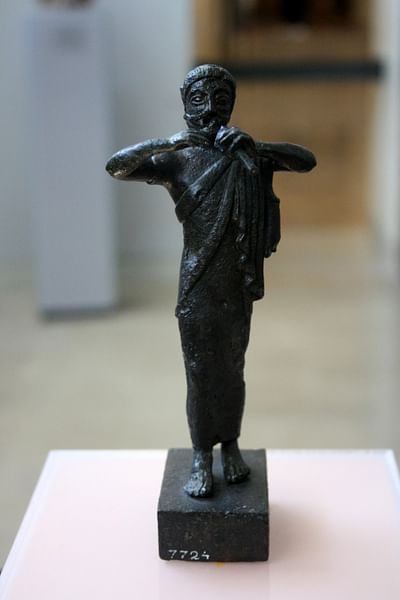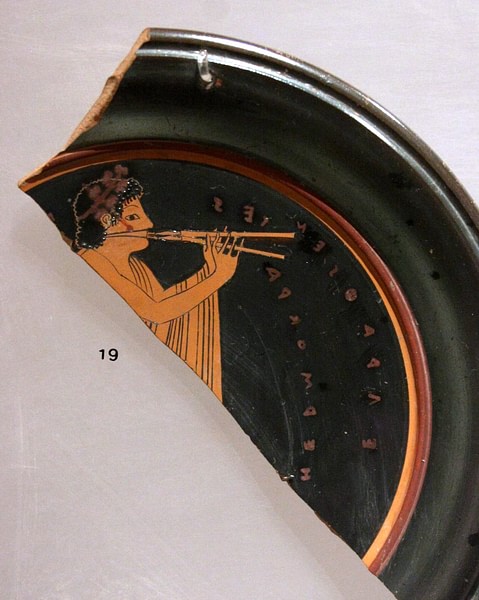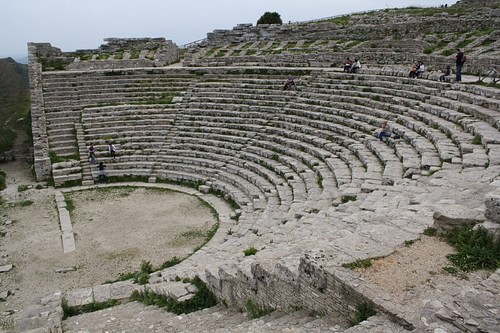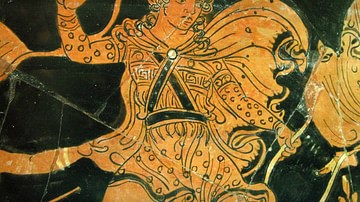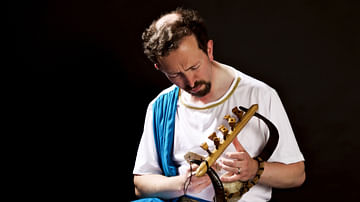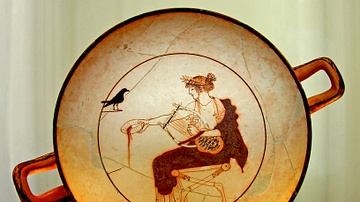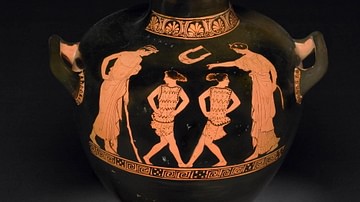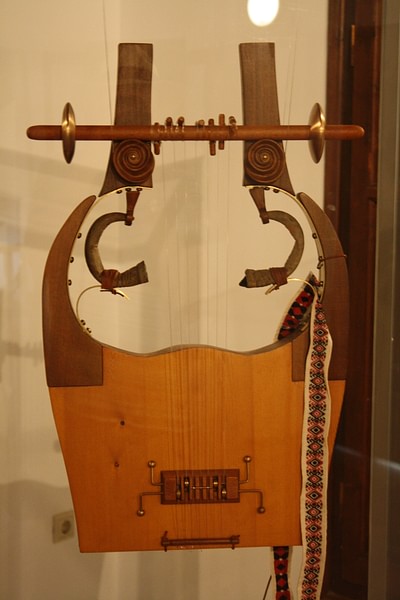
Music (or mousike) was an integral part of life in the ancient Greek world, and the term covered not only music but also dance, lyrics, and the performance of poetry. A wide range of instruments was used to perform music which was played on all manner of occasions such as religious ceremonies, festivals, private drinking parties (symposia), weddings, funerals, and during athletic and military activities. Music was also an important element of education and Greek drama performances held in theatres such as plays, recitals, and competitions.
Musical Origins
For the ancient Greeks, music was viewed as quite literally a gift from the gods. The invention of specific instruments is attributed to particular deities: Hermes the lyre, Pan the syrinx (panpipes) and Athena the aulos (flute). In Greek mythology the Muses personified the various elements of music (in the wide Greek sense of the term) and were said to entertain the gods on Mt. Olympus with their divine music, dancing, and singing. Other mythical figures strongly associated with music are the god of wine Dionysos and his followers the Satyrs and Maenads. Amphion and Thamyres were both famed for their skills playing the kithara (guitar) whilst Orpheus was celebrated as a magnificent singer and lyre player.
The oldest surviving Greek musical instruments are bone auloi which date from the Neolithic Age (7th-4th millennium BCE) and were found in western Macedonia, Thessaly, and Mykonos. The three major civilizations of the Bronze Age in the Aegean (3000 to 1000 BCE), Cycladic, Minoan, and Mycenaean Civilization, all provide physical evidence of the importance of music in their respective cultures. Marble figurines from the Cyclades represent players of both the aulos and the harp. Cretan hieroglyphic script has three symbols which are musical instruments - two types of harp and a sistrum (or rattle, originally from Egypt). An alabaster lyre decorated with swan heads survives from Knossos and a fresco at Akrotiri on Thera depicts a blue monkey playing a small triangular lyre. The Minoan 'Harvester Vase' (1500-1450 BCE) from Hagia Triada on Crete depicts a sistrum player and clay versions of the instrument have been found in graves across Crete. There is also some evidence that music may have been written down as early as the Bronze Age if a Minoan Linear A text on a wall in Hagia Triada is interpreted as such.
The combining of words and music, melodic and scalar systems, and several of the most popular musical instruments such as the aulos and lyre probably derived from the Near East. However, the Greeks themselves considered the lyre, in particular, as a 'Greek' instrument whilst the aulos is often represented in mythology as an inferior foreign competitor of Eastern origin. Hence, the great Greek god Apollo, who was believed to be the master of the lyre, defeated the Phrygian Satyr Marsyas and his aulos in a musical competition judged by the Muses. The lyre was also the musical instrument, above all others, which young Greeks had to learn in their schooling and was recommended as such by Plato in his Republic.
Musical Instruments
Greek musical instruments included stringed, wind, and percussion. By far the most popular were the lyre, aulos (usually double), and syrinx. Other instruments, however, included the rattle (sistrum and seistron), cymbals (kymbala), guitar (kithara), bagpipe (askaulos), conch and triton shells (kochlos), trumpet (salpinx), horn (keras), tambourine (rhoptron), shallow drum (tympanon), clappers (krotala), maracas (phormiskoi), xylophone (psithyra), various versions of the lyre such as the four-stringed lyre (phorminx) and the multi-stringed and elongated barbiton, and various types of harps, usually triangular shaped (e.g. the psalterion). Two unusual instruments were the rhombos (a wind instrument) which was a flat rhombus pierced with holes, strung on a cord, and played by spinning the cord. The second was the hydraulis, a sophisticated Hellenistic organ which used compressed air and water pressure maintained by two pedals. Incidentally, stringed instruments were always played with the fingers or a plectrum rather than with a bow and in the Classical Period, stringed instruments were favoured over wind as they allowed the player to also sing and, for the Greeks, words were considered more important than musical sounds.
Music Theory
There is evidence that the Greeks began to study music theory as early as the 6th century BCE. This consisted of harmonic, acoustic, scalar, and melody studies. The earliest surviving (but fragmentary) text on the subject is the Harmonic Elements by Aristoxenos, written in the 4th century BCE. Music also became an element of philosophical study, notably, by the followers of Pythagoras, who believed that music was a mathematical expression of the cosmic order. Music was also held to have certain therapeutic benefits, even medicinal powers over physical and mental illnesses.
In addition, one of the unique contributions the Greeks made to the history and development of music is that it can have a moral and emotional effect on the listener and his or her soul; in short, that music has an ethical role in society. For this reason, Plato, considering them rather decadent, banned instruments capable of producing all of the scales. Likewise, overcomplicated rhythms and music with too fast a tempo were considered morally dangerous in the great philosopher's ideal republic.
Regarding written music, 52 pieces of Greek music survive, albeit in a fragmentary form. For example, a musical excerpt from Euripedes' play Orestes survives, as does an inscription of music from the Athenian Treasury at Delphi. The most complete surviving piece of Greek music is the song of Seikilos from a 2nd century BCE tombstone found at Tralleis near Ephesus.
Musicians
Greek musicians were very often the composers and lyricists of the music they performed. Known as the 'makers of songs' or melopoioi, they created melos: a composition of words, tune, and rhythm. There is evidence that musicians enjoyed an elevated status in society as indicated by their particular robes and presence on royal household staff lists. There was even a specific symbol for musicians in the Cretan hieroglyphic script and the later Linear B. Professional musicians were male, although an exception were the courtesans or hetairai who performed at symposia. However, there are depictions in art of female musicians, notably the clay dancing lyre players from Palaikastro. Other professional musicians included the trieraules who set the beat for the rowers in triremes and trumpet players and choral singers who accompanied marching soldiers.
Music & Religion
Music and dancing accompanied processions on special religious occasions in various Greek cities and, amongst the most famous in the Greek world, were the Panathenaia and Great Dionysia festivals of Athens. Certain religious practices were usually performed to music, for example, sacrifices and the pouring of libations. Hymns (parabomia) and prayers (kateuches) were also sung during processions and at the altar itself. These were provided by choral groups of professional musicians, notably aulos players, often attached to particular sanctuaries, for example, the paeanists in Athens and the aoidoi and epispondorchestai in the sanctuary of Asclepius at Epidaurus.
Music, dance, poetry and drama recitals were also a competitive activity in events such as the pan-Hellenic festivals held at Isthmia, Delphi and Nemea. However, as with the athletic competitions, the music contests were of a religious nature in that excellence was offered to honour the gods. There were two types of such musical contest: stephanites (sacred with a symbolic wreath as the prize) and chrematites or thematikoi (with more tangible prizes such as money or precious goods). Sparta, Argos, and Paros held the earliest such competitions from the 7th century BCE. In Hellenistic times, musical festivals and competitions became so common that musicians and performing artists began to organise themselves into guilds or Koina.
Music & Education
Plato informs us that the first schools dedicated to musical education were created by the Cretans. However, the heyday of music in the classroom was during the 6th and 5th centuries BCE when schools of music were established in Athens where pupils aged between 13 and 16 were taught to play the lyre and kithara and to sing, accompanied by their teacher on the aulos. Music taught discipline and order and allowed the educated to better appreciate musical performance. Athletics and other sporting activities, another major element of the Greek education, were also done accompanied to music, particularly in order to increase synchronization.
Music for Pleasure
Music was a staple element of the symposium or all-male drinking party. After eating, the men each sang a song (skolia) with an aulos, lyre, or barbiton providing backing music. Often they sang amusing satirical songs (silloi). Finally, at the end of the evening, it was common for the group to take to the streets as a komos (band of revellers) and sing and dance their way through the town.
Women too could enjoy music in the privacy of their homes. Usually women played stringed instruments and recited poetry to music. In addition, household chores such as weaving and baking were done to music. Children too sang songs (agermos) at people's doors to receive small change and sweets just as carol-singers do today.
In the theatre, performances of Greek tragedy, comedy, and drama were all accompanied by music, and singing was provided by a designated chorus which consisted of as many as 24 singers in Greek theatre performances of the 5th century BCE.
Music in Art
Musicians and musical instruments were a popular subject on frescoes, in sculpture, and on Greek pottery, particularly in the geometric, black-figure and red-figure styles. Aside from all of the major figures of Greek Mythology previously mentioned, a notable addition to the subject of music on Greek pottery is the greatest of heroes Hercules. Late Archaic and Early Attic pottery often portray the hero with a kithara, and perhaps this symbolizes the association between physical and musical exercise which are necessary for a properly balanced education. Other great heroes such as Achilles, Theseus, and Paris are also sometimes portrayed playing a musical instrument (usually a lyre), once again reinforcing the dual aims of an aristocratic education and the virtue of music. Also, many school scenes on 5th-century BCE pottery depict students with both a lyre and a book-roll, illustrating once again the importance of music in education. Finally, Lekythoi, slim jars for holding perfumes, are commonly found in grave contexts and often have music as the subject of their decoration, perhaps in an attempt to ensure that the deceased was accompanied by music on their journey into the next life.

